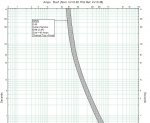hbendillo
Senior Member
- Location
- South carolina
I am working on a project where in an existing restaurant, they want to renovate a large storage space to a micro brewery. So, we want to take off an existing panelboard to feed the brewery. This panelboard is the only viable option from which to feed the brewery. Will only bore you with the details of how the service to this restaurant is configured if you really want to know. But this panelboard is not individually metered so there is no long term record of the actual load on this panelboard. So, I had them install a meter to record over five days to get some idea of what we have. Bottom line, the highest average on any one leg of this three-phase circuit is 58 amps; Max amps is 88.97. Circuit for the panel: 175 amp circuit breaker, 480 volt, three-phase.
Using NEC demand factors, the load for the brewery is 219 amps at 208-volt, three-phase which translates to about 95 amps at 480 volts. Total with new load is 152.9 amps on our 480-volt panelboard. Assuming the 175 amp breaker is standard 80% rated the continuous load rating is 140 amps. So we have a problem.
Now, I am pretty confident that the actual demand for this brewery is significantly lower. But thanks to the NEC I can't test that evaluation. And even if it would, recording for five days just isn't enough data to make such a decision.
I don't see any recourse other than upgrading the service to this panelboard. The feeder for this panelboard could be up to 300 feet from the main service panel which located in an electrical room that is a part of this mall property. I guess I am just searching for alternatives. I know the owner is not going to want to pay the additional cost to upgrade the feeder.
Using NEC demand factors, the load for the brewery is 219 amps at 208-volt, three-phase which translates to about 95 amps at 480 volts. Total with new load is 152.9 amps on our 480-volt panelboard. Assuming the 175 amp breaker is standard 80% rated the continuous load rating is 140 amps. So we have a problem.
Now, I am pretty confident that the actual demand for this brewery is significantly lower. But thanks to the NEC I can't test that evaluation. And even if it would, recording for five days just isn't enough data to make such a decision.
I don't see any recourse other than upgrading the service to this panelboard. The feeder for this panelboard could be up to 300 feet from the main service panel which located in an electrical room that is a part of this mall property. I guess I am just searching for alternatives. I know the owner is not going to want to pay the additional cost to upgrade the feeder.

